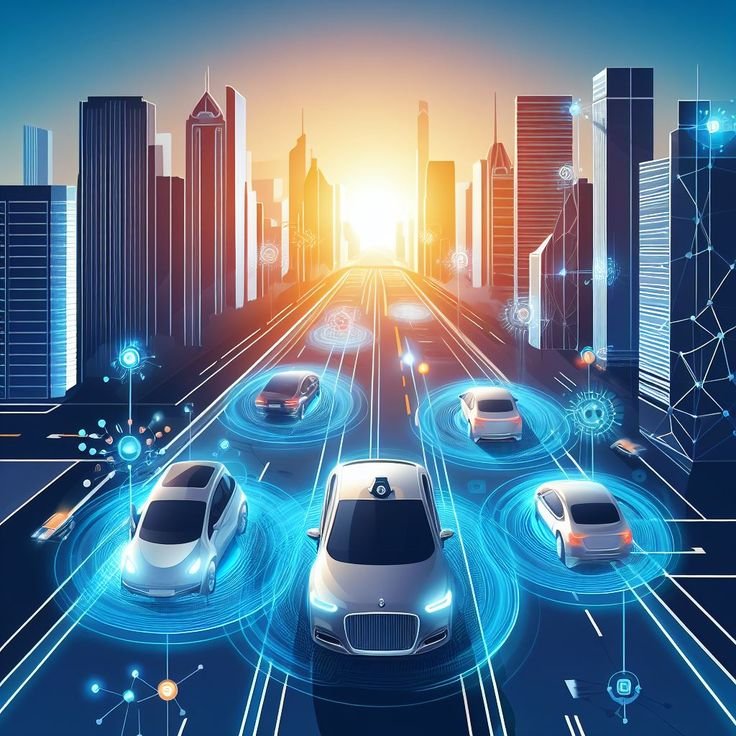
Edit Post
The future of autonomous vehicles holds vast implications. In urban areas, fleets of self-driving cars could reshape city planning, leading to redesigned infrastructure and more efficient land use. Commuters may reclaim time lost to driving, fostering productivity or relaxation during journeys. However, challenges persist, including regulatory hurdles, public acceptance, and concerns over job disp... View more
The future of autonomous vehicles holds vast implications. In urban areas, fleets of self-driving cars could reshape city planning, leading to redesigned infrastructure and more efficient land use. Commuters may reclaim time lost to driving, fostering productivity or relaxation during journeys. However, challenges persist, including regulatory hurdles, public acceptance, and concerns over job displacement in transportation sectors.The societal impact of autonomous vehicles extends beyond transportation, influencing sectors like insurance, real estate, and retail. Ethical dilemmas surrounding AI decision-making in critical situations remain unresolved. Nonetheless, as technology advances and adoption grows, autonomous vehicles have the potential to fundamentally redefine how we move, work, and interact, ushering in a new era of mobility and urban living. View less
- 2 2
- 0 0
-

-
Ajith L Rajan
published solution: 1 year beforeBy the year 2028, autonomous vehicle technology is likely to have advanced significantly, with widespread adoption and continued improvements in safety, efficiency, and accessibility. Self-driving cars may become a common sight on roads, offering passengers a convenient and hands-free transportation experience. These vehicles will be equipped with advanced sensors, cameras, and artificial intelligence algorithms that enable them to perceive and navigate their surroundings autonomously. Moreover, the integration of vehicle-to-everything (V2X) communication technology will enable autonomous vehicles to communicate with each other and with infrastructure, enhancing coordination and safety on the roads. Additionally, advancements in battery technology and electric vehicle (EV) infrastructure will facilitate the transition towards autonomous electric fleets, reducing emissions and environmental impact. However, as autonomous vehicle technology matures, challenges such as regulatory hurdles, cybersecurity threats, and ethical considerations surrounding decision-making algorithms will need to be addressed. Collaborative efforts between government agencies, industry stakeholders, and research institutions will be essential in establishing regulatory frameworks, standards, and best practices to ensure the safe and responsible deployment of autonomous vehicles by 2028.
0 1 0 0 1 0 -
rachel varghese
published solution: 1 year beforeThe future of autonomous vehicle technology holds promise for safer roads, increased convenience, and improved efficiency. With advancements in AI, sensors, and connectivity, self-driving cars are becoming more reliable and capable. However, challenges like regulatory hurdles, public acceptance, and cybersecurity remain. Overall, expect continued innovation and gradual integration of autonomous vehicles into our transportation systems, transforming how we travel.
1 2 0 0 1 0 -
Vishnu Divakar J.S
published solution: 1 year beforeThe future of autonomous vehicle technology will likely see widespread adoption as the technology becomes more refined and trusted. This could lead to safer roads, increased efficiency in transportation, and potentially transformative changes in urban planning and personal mobility.
1 2 0 0 1 0 -
RAHUL BABU
published solution: 1 year beforeThe future of autonomous vehicle technology holds immense promise. It has the potential to revolutionize transportation, making it safer, more convenient, and enjoyable for consumers. By 2035, it could generate $300 to $400 billion in revenue, benefiting both drivers and the auto industry
1 2 0 0 1 0 -
Diya Fathima
published solution: 1 year beforeIn the future, self-driving cars could change city planning and how we use land. People can use their commute time for work or relaxation. But challenges like rules, public opinion, and job loss need addressing. This tech will affect insurance, real estate, and shopping. There are still ethical questions about AI in emergencies. Despite challenges, as tech improves, self-driving cars might reshape how we live and move around cities.
1 2 0 0 1 0 -
Diya Fathima
published solution: 1 year beforeIn the future, self-driving cars could change city planning and how we use land. People can use their commute time for work or relaxation. But challenges like rules, public opinion, and job loss need addressing. This tech will affect insurance, real estate, and shopping. There are still ethical questions about AI in emergencies. Despite challenges, as tech improves, self-driving cars might reshape how we live and move around cities.
0 1 0 0 1 0 -
Ajith L Rajan
published solution: 1 year beforeThe future of autonomous vehicle technology by 2028 is expected to be marked by significant growth and adoption. According to reports, the autonomous vehicle market in India is projected to grow at a CAGR of 21.5% during 2023-2028, driven by the increasing demand for autonomous technologies in various sectors such as agriculture, fleet management, and shuttles. The Indian government's ambitious plan to increase the adoption of electric vehicles to 30% by 2030 will also contribute to the growth of autonomous vehicles. Additionally, the development of infrastructure and the integration of autonomous technologies into various industries such as healthcare and logistics are expected to further accelerate the adoption of autonomous vehicles. By 2028, India is likely to see a substantial increase in the number of autonomous vehicles on its roads, transforming the transportation landscape and improving road safety and efficiency.
0 1 0 0 1 0


